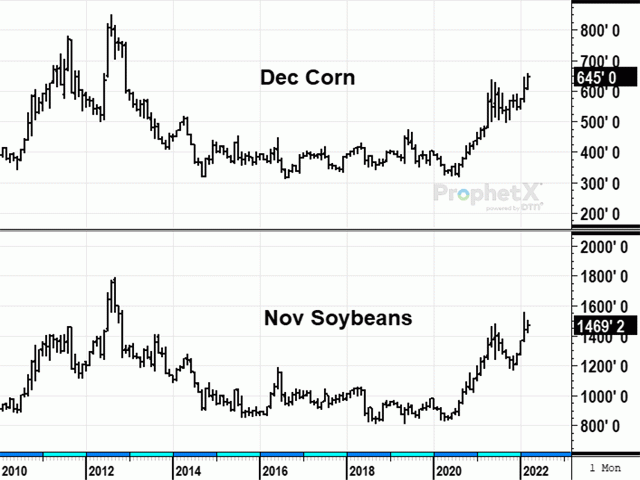Todd's Take
Russia-Ukraine War Adds to Market Volatility, Complicates New-Crop Sales in 2022
If I could have told you two years ago producers could grow corn in 2022 and lock in a new-crop price of $6.45 a bushel, many would have had the same response: Sign us up! The same goes for new-crop soybean prices at $14.69. Compared to last year's production cost average of $10 a bushel, that would have looked like a good deal.
Of course, this year, there is more than one catch. When I tell your younger self the national average price of anhydrous is near $1,500 a ton and potash is over $800 a ton in 2022, more than a few eyebrows would be raised. And diesel above $5 a gallon is no help either. But even those higher expenses would still pencil out favorably if you live in a part of the country that normally gets average or higher corn and soybean yields. $6.45 corn and $14.69 soybeans still look good in those scenarios.
There is another problem I would have to tell you about, however. Crazy Vladimir lost his marbles and attacked Ukraine for no good reason. I wish I were making that up, but we all know at this point I'm not. That S.O.B. is shelling the hell out of Ukraine's largest cities and relentlessly bombing civilian neighborhoods.
God bless the Ukrainians. While millions are fleeing for their lives, many are staying and fighting back with everything they've got. One story on Twitter told about an elderly woman who threw a jar of pickles from her apartment balcony and took down a Russian drone. I don't know if that is true, but everything inside me hopes it is.
Back to the topic of making new-crop sales, there is a new problem we normally don't worry much about but need to consider before making any sales commitments in 2022, and that is the potential of even more price volatility in markets than we have seen to date.
For example, let's say you're in a part of the Corn Belt that normally has high yields and is not threatened by drought. You sell December corn futures at $6.45, representing 50% of your expected corn production in 2022. Hopefully, you're working with a banker that agrees to finance your margin calls; but for many, that agreement may be informal, or you may not confer with a banker at all.
P[L1] D[0x0] M[300x250] OOP[F] ADUNIT[] T[]
What if crazy Vladimir does something really crazy that spooks the markets? He has threatened to use nuclear weapons, and on Thursday, Reuters reported a Russian official as saying, "Russia has the might to put all our brash enemies in their place." (https://www.reuters.com/…)
I am not trying to unduly scare anyone, but I also believe it is reasonable to prepare for the possibility Russia's president may turn up the heat if things don't go his way. As we have already seen a little taste of, it doesn't take a lot to scare markets. If you are going to hold new-crop hedges, you need to ask yourself: Do I have the margin to stay with a corn price that goes to $9, $12, or higher? If not, you had better consider buying a call option to go with that futures hedge.
A few examples from Thursday's closes show a December 2022 $8 corn call at 31 cents, a $9 corn call a little above 18 cents and a $10 call at 10 cents. Are those outrageously high prices for corn? Yes, they are, but given the risk of the situation, minimizing a possible disaster is worth it.
In November 2022 soybeans, a $16 call is roughly 72 cents, an $18 call is 36 cents and a $20 call is roughly 18 cents. Keep in mind options can lack sufficient trading volume, resulting in spreads between bids and offers that can be wider than many realize. It's usually a good idea to ask your broker for help when trying to price option trades.
Another possibility for making new-crop sales is to go to your local elevators or commercial buyers and let them worry about meeting the financial requirements of a new-crop sale. You may not get as good a price as the $6.45 quoted on the futures board, but the lack of margin calls could be well worth it.
In that case, I would pass along the advice DTN Contributing Analyst Tregg Cronin gave to an audience at DTN's Ag Summit in December: Spread your risk among more than one commercial buyer. In this highly uncertain predicament, there is an increased risk of financial problems emerging from markets that make big moves in short periods of time.
Just recently, Bloomberg and the Financial Times each ran stories on large commercial traders asking for help in making margin calls that had quickly become much larger than expected. It is difficult to get information about overdue margin calls from exchanges, but I think there is no doubt the financial system has been stressed by large and sudden price moves in March.
I pray 2022 does not get any worse than it already is but have to acknowledge the pieces are in place to put the futures exchange and grain-handling commercials to an extreme test. The good news is that prices are high, and after drought in Brazil and lacking Ukraine's exports, this may be a good year to do without the hassle of making new-crop sales. Best wishes on a volatile journey.
**
Comments above are for educational purposes only and are not meant as specific trade recommendations. The buying and selling of grain or grain futures or options involve substantial risk and are not suitable for everyone.
Todd Hultman can be found at Todd.Hultman@dtn.com
Follow him on Twitter @ToddHultman1
(c) Copyright 2022 DTN, LLC. All rights reserved.




